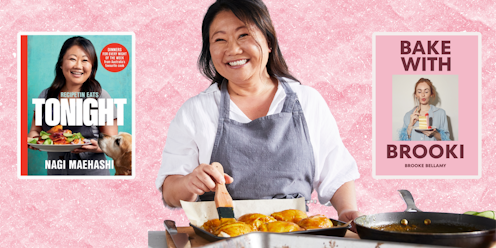RecipeTin Eats founder accuses cookbook author of plagiarism. Can a recipe be copyrighted? A legal expert explains
- Written by The Conversation

Bestselling cookbook author Nagi Maehashi, founder of food blog RecipeTin Eats, has accused Brooke Bellamy, bakery owner and author of Bake With Brooki, of plagiarising two of her recipes, for caramel slice and baklava. She also claims Bellamy has used uncredited recipes from other, unnamed cookbook authors.
On Instagram, Maeheshi called the similarities “so specific and detailed that calling these a coincidence feels disingenuous”. Bellamy denied the allegations, as has her publisher, via their lawyers. “I did not plagiarise any recipes in my book which consists of 100 recipes I have created over many years,” Bellamy wrote, according to the Age.
Family recipes have been shared and handed down from generation to generation. But recipes can also be big money.
Maehashi’s two cookbooks have made more than A$34 million in sales so far, reports The Australian: her debut cookbook, RecipeTin: Eats (Dinner) has sold more than 350,000 copies, and her follow-up, RecipeTin: Eats (Tonight) 337,000. Bake with Brooki is big business too, with almost 100,000 copies sold since its publication in October 2024.
I’m not suggesting plagiarism has occurred, only that allegations have been made. It raises a fascinating question: can recipes be protected by copyright?
What does the law say?
The legal position is far from clear. While you cannot copyright a recipe itself, you might be able to protect the specific way it is expressed.
The know-how that forms a recipe – like how to make a cake – cannot be protected by copyright, for a couple of reasons. First, copyright does not protect mere ideas: it only protects the specific ways these ideas are expressed. This is a very important principle. It means the building blocks of creativity – ideas – are free for anyone to use.
A set of ingredients, the ratio for their inclusion, a basic cooking method, and a standard recipe layout are all examples of unprotectable ideas.
Second, copyright only protects things that are recorded: either in writing or some other way, such as sound recording or film. Your granny’s lemon slice made from memory is not a copyright work. In fact, a European Union court has even decided the taste of a cheese is not a protectable work.
The upshot of this, however, is that particular written explanations of recipes might be protected by copyright. A written text just needs to be composed of words that have some meaning for copyright to protect it as a “literary work”. Even relatively mundane written documents, such as exam papers or instruction manuals, can be protected by copyright as literary works.
To have rights in a recipe as its author, the input required is relatively minimal. To be “original” enough in copyright’s eyes, a recipe should not be an exact copy of another and some personal effort and thought must have gone into its expression.
Still, even this might be hard to establish for very simple recipes, where there is very little to no room for creative choice in their explanation. Some recipes are so basic or well known that it might be difficult to find a personal or unique way to express them.
Things also become complicated when considering whether a recipe’s copyright has been infringed. You can’t infringe copyright in a recipe, for example, by making the dish described. A cake itself is so changed in form from the written instructions in a recipe that it can’t really be seen as a “copy” of the words in the recipe.
What’s more, the simpler a recipe, the more exact a written copy needs to be for infringement to be established. What is unique, personal and protectable in a recipe might be quite limited. By their nature, certain dishes will require certain ingredients to be added in a certain order.
Where do we draw the line?
Disputes about recipe copying raise an age-old question for copyright: where do we draw the line between inspiration and infringement?
One argument against copyright infringement relating to a recipe might be that the similarities come not from copying, but from an independent attempt to solve the same problem – such as how to explain a particular cooking method. Independent creation is always a complete defence to a claim of copyright infringement.
Disputes on social media about content creators copying the work of others abound. Last year, for example, the New York Times reported on a legal case where one Instagrammer accused another of copying her minimalist aesthetic or style. With the proliferation of content and sharing across social media, the line between inspiration and infringement is more blurred than ever.
Interestingly, there is special legal protection for Anzac biscuits – you cannot commercially produce and sell “Anzac” biscuits unless they are made to a specific recipe and shape. This is explained in official guidelines, published by the Australian Department of Veteran Affairs. It is one of many restrictions on the use of the word “Anzac”.
Copyright may not always provide the clear answers content creators seek, but its flexible rules leave space for new culinary creations and recreations. Does the law get the balance right? Without more legal cases it’s hard to know – the proof of the pudding is in the eating.







